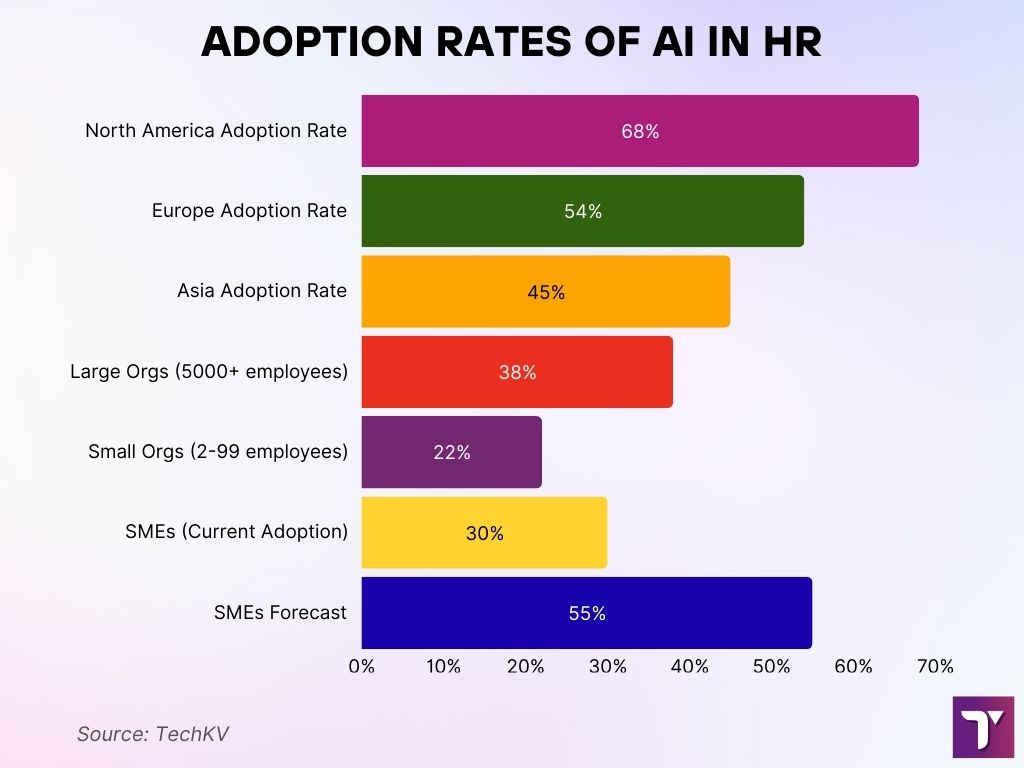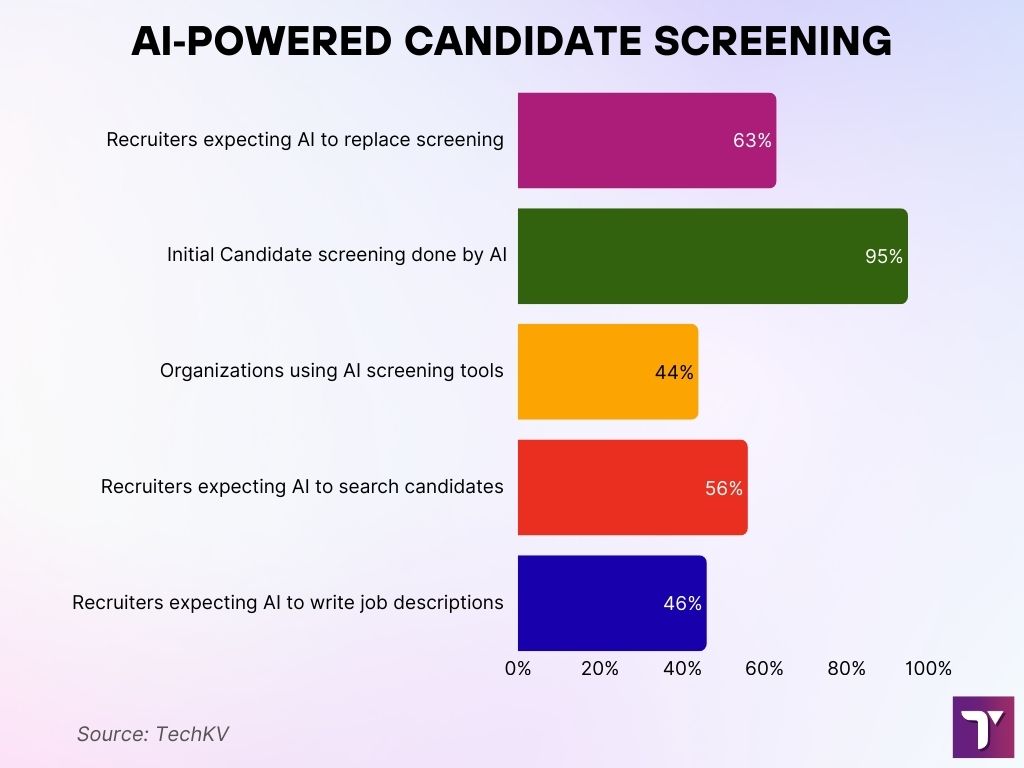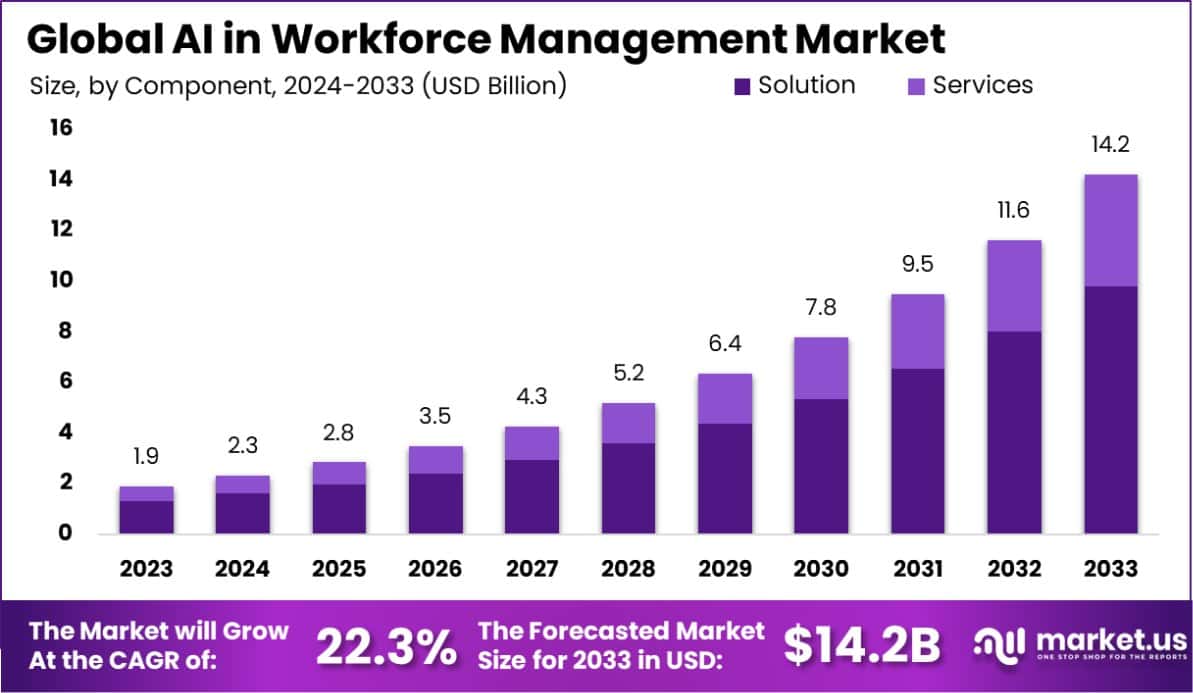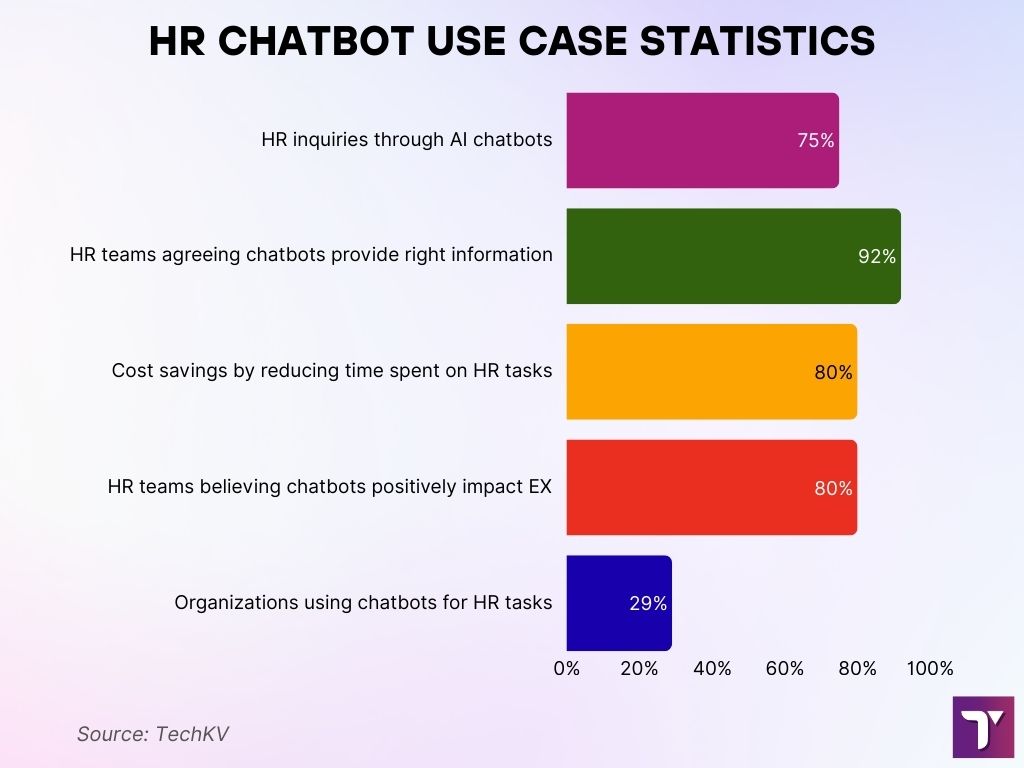AI is reshaping Human Resources faster than many expected. 43% of organizations now use AI in HR tasks, a sharp jump from 26% in 2024. It powers everything from candidate screening to employee engagement. In finance, companies use AI to reduce hiring bias. In tech, AI streamlines onboarding workflows. These shifts are not hypothetical; they affect hiring speed, costs, and workforce planning now. Dive into the stats to understand where HR is headed.
Editor’s Choice
- 43% of organizations use AI in HR tasks now, up from 26% in 2024.
- Global AI in HR market size is projected to rise from $6.05 billion in 2024 to $14.08 billion by 2029.
- The global AI in HR market was estimated at $3.25 billion in 2023, and is expected to grow to $15.24 billion by 2030, CAGR ~24.8%.
- 63% of recruiters believe AI will replace candidate screening in the future.
- By 2025, 80% of organizations will integrate AI into HR functions.
- Over the next three years, 92% of companies plan to increase their investment in AI.
- Only 1% of organizations consider their AI deployments in HR to be fully mature.
Recent Developments
- AI adoption in HR rose from 26% in 2024 to 43% in 2025 among organizations.
- 78% of companies use AI in at least one business function in 2025, up from about 55% a year earlier.
- Over 92% of companies plan to increase AI investments over the next three years.
- The global AI‑HR market was expected to reach $6.99 billion in 2025.
- AI‑powered HR software tools are increasingly common, especially those for automation in recruitment, onboarding, and performance analytics.
- Only 1% of organizations believe their AI deployment is fully mature.
- The number of HR departments raising their AI budget is rising; nearly 45% in 2024 were planning to increase allocation toward AI‑based HR tools.
- Emerging focus areas include AI for predictive analytics, chatbots, and writing job descriptions.
Adoption Rates of AI in HR
- Global AI adoption in HR, around 50% of organizations had integrated AI tools for HR by 2024.
- In North America, about 68% of HR departments use AI tools, in Europe, roughly 54%, and Asia trails at 45%.
- Among larger organizations (5,000+ employees), 38% use AI in HR functions, and small organizations (2‑99 employees) show about 22% usage.
- AI adoption within HR is growing at approximately 15‑20% per year globally.
- SMEs, ~30% have already adopted AI HR tools, forecast is to reach ~55% by 2025.
- In a U.S. Census Bureau survey, AI usage among large firms dropped slightly in mid‑2025 (from 13.5% to ~12%), and smaller firms had varied trends.
- AI deployment maturity remains rare, with only 1% fully mature.
- Most organizations are using AI in multiple HR functions, not just a single use case.

Market Growth and Size of AI in HR
- Global market size was $3.25 billion in 2023, projected to reach $15.24 billion by 2030, with a CAGR of ~24.8% from 2024‑2030.
- The market is expected to grow from $6.05 billion in 2024 to about $14.08 billion by 2029.
- The HR tech market (broader scope) was valued at over $6 billion in 2024 and is expected to rise substantially by 2029.
- People Analytics software alone is estimated at $4.87 billion in 2025, with forecasts toward $8.92 billion by 2030.
- AI‑powered HR software tools focus heavily on recruitment automation, employee engagement, and performance analytics.
- North America currently holds the largest share of AI in the HR market revenue.
- The cloud deployment model leads among deployments in 2023.
- Large enterprises account for the biggest chunk of market share, by enterprise size, especially in AI HR solutions.
AI in Talent Acquisition and Recruitment
- 63% of recruiters believe AI will eventually replace candidate screening.
- 35.5% of small and medium businesses are allocating budget toward recruiting tools using AI or ML.
- 24% of mid‑market companies plan to invest in AI‑powered recruitment tools.
- 58% of organizations expect AI to assist in writing job descriptions in the coming years.
- 53% of organizations plan to use chatbots for candidate engagement.
- 44% plan to use resume screening and parsing via AI.
- 48% expect to partially or fully automate interview scheduling.
- 80% of organizations plan to integrate AI into HR functions by 2025, and recruitment is one of the core functions.
AI‑Powered Candidate Screening
- 63% of recruiters believe AI will replace candidate screening in the future.
- Nearly 95% of initial candidate screening will be handled using AI in 2025.
- AI screening tools, including resume parsing and interview scheduling, are being adopted by more than 44% of organizations.
- The accuracy of modern AI‑driven candidate matching tools ranges between 85% and 95%.
- AI tools are used to search for candidates on multiple platforms. 56% of recruiters expect that part of their process will be replaced by AI.
- 46% expect AI to help generate job descriptions.
- Ethical concerns persist, some job seekers feel AI screening is impersonal, and others worry about bias and transparency.
- AI screening reduces time‑to‑hire in many cases, though exact averages vary.

AI in Employee Onboarding
- Around 35% of organizations plan to automate onboarding processes via AI in the next two years.
- Onboarding tools using AI include automated document handling, chatbots, and personalized training paths.
- Firms with higher investment in HR tech are more likely to adopt AI onboarding, large enterprises.
- AI can reduce administrative overhead in onboarding by automating scheduling, form filling, and compliance tracking.
- Some companies use predictive analytics in onboarding to forecast which new hires might struggle, so they can intervene early.
Automation in HR Processes
- 13% of surveyed large organizations plan to reduce HR headcount by an average of 22%, relying on generative AI and automation to handle core HR tasks.
- As of mid‑2025, only 19% of core HR processes in Europe are enhanced with generative AI, 32% are still in pilot phases.
- Shared‑services centers in HR are used by 18% of organizations with more than 1,000 employees to scale automation and standardize processes.
- HR departments cite administrative burden (e.g., payroll, benefits, compliance) as among the top use‑cases for automation in 2025.
- Automation in HR has led to time savings and efficiency gains. In recruiting tasks, 89% of HR professionals say AI use saves time or increases efficiency.
- Over 1 in 3 (36%) organizations report that using AI in recruiting helps reduce recruitment, interviewing, or hiring costs.
- HR pros expect automation combined with AI to handle more routine tasks by 2026, freeing human HR staff to focus on strategic and relational work.
AI in Workforce Planning and HR Analytics
- By 2025, 80% of organizations are projected to use AI for workforce planning.
- Only 32% of organizations use predictive workforce analytics regularly, despite higher rates of daily AI tool interaction among employees.
- 72% of HR professionals believe AI improves workforce planning capabilities.
- AI dashboards and visualizations enhance decision‑making in HR by about 60%.
- AI tools enable forecasting of skills gaps up to three years in advance.
- Workforce analytics driven by AI reduces labor and hiring costs, and predictive scheduling reduces labor costs by ~18%.
- Attrition models powered by AI have helped companies avoid millions in rehiring costs by identifying at‑risk employees early.
Global AI in Workforce Management Market
- The global market was valued at $1.9 billion in 2023.
- It grew to $2.3 billion in 2024 and is projected to hit $2.8 billion in 2025.
- By 2026, the market size is expected to reach $3.5 billion, showing steady annual growth.
- Forecasts suggest further expansion to $4.3 billion in 2027 and $5.2 billion in 2028.
- $6.4 billion, nearly triple its 2023 size.
- The decade closes with strong projections: $7.8 billion in 2030, $9.5 billion in 2031, and $11.6 billion in 2032.
- By 2033, the market is forecasted to hit $14.2 billion, marking a compound annual growth rate (CAGR) of 22.3%.

Employee Engagement and Satisfaction
- 52% of organizations use AI tools specifically for measuring or boosting employee engagement and satisfaction.
- When AI is used in HR processes, 65% of employees report higher engagement.
- Employee engagement surveys powered by AI saw response rates increase by ~45%.
- AI‑driven sentiment analysis allows HR to detect disengagement or morale issues 25% faster.
- 52% of respondents say they’re “worried” about how AI might affect their workplaces, while 36% say they’re “hopeful”.
- Real‑time feedback tools and AI agents help provide personalized experiences, which contribute to higher satisfaction scores.
- 70% of employees expect personalized AI‑driven career development by 2025.
Performance Management
- 58% of organizations currently use AI in performance management.
- 65% of HR professionals believe AI improves the efficiency of performance management systems.
- AI‑generated performance reviews improved productivity by around 22%.
- AI reduces bias in performance reviews by approximately 25%.
- Sentiment analysis detects declining performance or disengagement about 25% faster.
- Organizations using AI feedback and evaluation models see improved leadership identification with accuracies up to 80%.
- Many organizations aim for real‑time performance tracking in core roles by 2025.
Payroll Management
- 77% of HR executives already use AI in payroll processing.
- By 2027, 60% of payroll questions will be answered by AI assistants, reducing manual queries.
- AI‑driven payroll systems are expected to reduce errors by ~90% by 2025 compared to traditional processes.
- Organizations using AI for payroll report faster compliance updates, especially in multi‑jurisdiction operations.
- Automation in payroll streamlines administrative tasks: organizing employee data, updating records, and approving changes.
- Some payroll systems integrate AI‑driven fraud detection or anomaly detection.
- 65% of workers report AI has had a favorable impact on HR functions, including payroll.
- Only 30‑40% of organizations have fully transitioned to end‑to‑end AI payroll systems.
AI‑Enabled Employee Retention Strategies
- AI tools tracking engagement and sentiment lead to 20‑25% lower turnover in certain departments.
- Attrition prediction models can reduce turnover by as much as 30% when used proactively.
- Personalized career pathing via AI is increasingly expected; 70% of employees look for it.
- Retention strategies now include tailored rewards, benefits, or work flexibility based on predictive signals.
- AI monitors workload and burnout indicators to flag at‑risk employees.
- Retention programs powered by AI reduce rehiring costs and productivity loss.
- Misleading or biased data can misdirect AI efforts and harm retention strategies.
HR Chatbot Use Case Statistics
- 75% of HR inquiries are expected to be handled through AI chatbots.
- 92% of HR teams agree that chatbots provide the right information to employees.
- Organizations can achieve cost savings of up to 80% by reducing time spent on HR tasks through chatbot automation.
- 80% of HR professionals believe chatbots can positively impact the employee experience (EX).
- Currently, only 29% of organizations report using chatbots for HR tasks and processes, showing room for growth.

Challenges of AI Adoption in HR
- AI bias remains a concern; tools may perpetuate inequalities based on past data.
- Over 50% of HR professionals express concern about privacy and data security.
- Many AI systems are opaque, making decision logic hard to interpret.
- ~45% of firms anticipate skill gaps in AI management and understanding.
- 47% of organizations struggle to integrate AI with existing HR systems.
- Laws like GDPR and state‑level AI fairness laws increase compliance pressure.
- Cultural resistance persists from managers or staff who are uncomfortable with automated tools.
Compliance and Ethical Considerations with AI in HR
- 67% of HR leaders list ethical AI usage as a strategic priority.
- 78% of employees expect transparency in AI‑based HR decisions.
- 80% of organizations are expected to form AI ethics committees by 2025.
- Data protection laws enforce cautious handling of sensitive HR and candidate data.
- Explainability is critical; firms must justify AI‑based rejections or decisions.
- Ethical frameworks emphasize human oversight, fair data sets, and consent practices.
- Fast AI adoption without ethics oversight can lead to legal and reputational risks.
Impact of AI on HR Costs and Efficiency
- Companies save time through automation of payroll, recruiting, and onboarding.
- AI cuts recruitment and interviewing costs by 20‑30% by automating tasks.
- Error reduction in payroll lowers rework and compliance costs.
- AI‑enabled retention efforts avoid millions in hiring and lost productivity costs.
- Faster decision‑making and automation speed up HR operations.
- AI tools allow HR teams to shift from admin work to strategic planning.
- Initial AI investments can be high; ROI depends on rollout scale and tool maturity.
Frequently Asked Questions (FAQs)
About 44% of organizations use AI for recruitment and talent acquisition
AI‑powered hiring tools can reduce recruitment costs by up to 30%.
27% of white‑collar employees report frequently using AI in 2025, up about 12 percentage points from 2024.
The AI in HR market size is projected to grow to $14.08 billion by 2029.
Predictive AI models can anticipate employee turnover with about 87% accuracy.
Conclusion
AI in HR is no longer optional; it’s a competitive imperative. From payroll automation to predictive analytics, retention strategies, and ethical frameworks, HR teams are using AI to boost efficiency, reduce costs, and make more data‑driven decisions. Yet risks like bias, lack of transparency, data privacy, and integration complexity remain real. The organizations that succeed will be those that pair technological capability with strong ethics, clean data, and skilled people. HR leaders must stay informed and intentional in how they deploy AI, because the tools or choices made now set the foundation for the workforce of tomorrow.
